
7 Superb Symmetry Activities (with a FREEBIE!)
- Freebies , Math , Planning

In the hustle and bustle of the upper elementary classroom, where every moment is precious and every standard is vital, it can be difficult to give every last educational concept the attention it deserves. This is especially true when a concept only has one or two standards addressing it. If it only has one standard in all of upper elementary, then it must not be too important, right?
… Or, maybe, the concept is just SO important that it only needs to be covered once to make a lasting impact on your kiddos! That’s what I’m choosing to believe, anyway, when it comes to symmetry. Maybe it’s my artistic side speaking, but I absolutely LOVE symmetry, and it actually hurts my feelings that this geometry concept doesn’t always get the attention it deserves.
For instance, when conducting my research for this blog post, I noticed a severe lack of educational resources and ideas that align with the Common Core State Standard 4.G.3 : “Recognize a line of symmetry for a two-dimensional figure as a line across the figure such that the figure can be folded along the line into matching parts. Identify line-symmetric figures and draw lines of symmetry.”
It’s obviously important to ensure your kiddos are meeting CCSS, but once that goal is met, symmetry can sometimes fall to the wayside. It’s understandable, since there are simply SO MANY standards to get to, but symmetry really is important in its own right!
Let’s check out why it’s vital to students’ mathematical careers, then we’ll dive into seven symmetry activities that are sure to supplement your geometry lessons… Complete with a FREEBIE at the end!
Why Bother with Symmetry?
It’s not just important to cover symmetry in preparation for testing. Exploring symmetry helps students build fluency in math by reinforcing key concepts like congruence, transformations, and geometric properties. By working through engaging, hands-on symmetry activities and discussions, students develop a stronger understanding of math principles and develop fluency in applying them to new situations.
In addition, building a strong foundation in symmetry also helps students develop spatial reasoning skills, which are super important for understanding tougher geometric concepts and spatial relationships down the line. It’s a great way to help students learn to visualize shapes, identify patterns, and make predictions.
There’s also plenty of symmetry to be found in nature, too! This is certainly a neat way to make real-world connections with your kiddos, but beyond that, it also provides you with a great opportunity for an integrated curriculum with Earth science… Which, as you know, is like, my favorite thing ever . 😉
Okay, I think I’ve made my point. Let’s jump right into the activities!

Seven Symmetry Activities
1. symmetry art swap.
For this activity, you’ll want to provide individuals with graph paper and art supplies. Every student will begin by creating a “line of symmetry,” preferably horizontal or vertical to begin with, through the center of the page. Then, they can create a geometric design of their liking on ONE side of the mirror line. Of course, students should be given free agency with their designs, but you may want to encourage simpler designs to start with to allow kiddos to get the hang of the concept of symmetry.
Once students have created their designs on one side of the mirror line, have them swap their graph paper with a partner. The partner should then try to finish the design on the other side of the symmetry line! Since this is a pretty quick activity, I recommend having students repeat these steps a few more times. They can experiment with more complex designs and even add colors to be mirrored!
It’s not a bad idea either to encourage kiddos to find NEW partners every time, too. You don’t want them sticking to only their best friend—switch it up so everyone gets a diverse experience.
These symmetry art pieces can be shown off in the classroom or even a hallway bulletin board for a cute, easy display. Kiddos love showing off their work, and a splash of color in the halls always does wonders to brighten spirits!
2. Symmetry Manipulatives
Similar to the art swap above, this is another way for students to express their creativity by creating symmetrical designs. This time, though, they can only use manipulatives, such as pattern blocks, tangrams, or other physical geometrical shapes. It’s a bit more challenging than the art swap, since they don’t have complete freedom over the design; rather, they’re bound by the dimensions of the trapezoids and rhombuses and squares!
For this activity, have students sit across from one another and try to replicate one another’s designs using the pattern blocks. They should notice that the design is “mirrored” across a horizontal line of symmetry between them. Kiddos can even take turns making designs and creating a symmetrical version.

3. Symmetry Construction
If someone had told me back at university just how much I’d end up advocating for the use of toothpicks in the classroom, I would never have believed them… But, goodness, there’s no denying their myriad of uses! From fencing in animals to investigating camouflage , toothpicks are practically the backbone of hands-on activities.
And, as you’re sure to see, geometry is no exception! For this activity, have students use toothpicks to create symmetrical shapes. They can connect the toothpicks (or even popsicle sticks, if you prefer) at their endpoints to form geometric shapes, then identify and label the lines of symmetry within their creations—or you can have a partner do that part.
Challenge students to see how many lines of symmetry they can create within one design! Of course, in that case, you may want to ban circles… That might be a little too easy. 😉
4. Symmetry Scavenger Hunt
Listen, I know I recommend scavenger hunts, like, ALL the time, but you can’t blame me: they’re a perfect way to get students up and moving around, keeping them engaged while staying on-task!
For this activity, you’ll encourage kiddos to engage with a geometric scavenger hunt around the classroom, encouraging them to search for symmetrical objects or patterns. If you’d like, you can set out symmetrical pictures or the like ahead of time, but that’s not totally necessary; most classrooms are already chock-full of symmetry if you take the time to look!
Have students record their findings in a notebook or on a piece of paper as they move through the scavenger hunt. They should sketch all of the items they discover that are symmetrical and draw its lines of symmetry—for instance, they could draw the top-down view of a desk and include all of its symmetrical lines.
Once students have had enough time to scan the entire room, reconvene as a class and discuss their findings. Encourage productive discussion by asking questions, such as “Which objects have the most symmetrical lines?” and even deeper critical-thinking questions like “Would the entire classroom be symmetrical if it were mirrored? Why or why not?”
5. Symmetry Nature Walk
What’s this? Another opportunity to integrate curriculum? You got it! Add a helping of Earth science to your geometry unit by bringing students outside to make mathematical observations about nature.
Before heading outside, however, it’s time for a brainstorm sesh. As a class, discuss what kinds of symmetrical objects you may find outside! This is a good way to get students visualizing symmetry, which is a vital step to fully grasping geometry.
Then… Go outside! Just like with the scavenger hunt, have kiddos bring along paper in order to sketch images of the symmetrical objects they find along with their lines of symmetry. Some common examples they may find outside are leaves, flowers, and even insects!

After the adventure, reconvene in the classroom and have students share their findings. Ask more questions, like which objects outside had the most lines of symmetry, if there were any perfectly symmetrical objects (like circles) and so on.
This is a great opportunity for critical thinking, too! What observations can your students make about symmetry in nature? Is it common? Lots of wildlife is symmetrical to some degree, like humans. Why do they think this is? There are no right or wrong answers; the exercise is simply meant to get students thinking and visualizing!
6. Symmetry Stations
Next up, set up several different stations around the room that each center around a type of geometric shape, such as circles and ovals, triangles, parallelograms, and other shapes, like hearts, crosses, arrows, stars, and so on.
Each station should have around five “cards” each that have a different shape relevant to the station’s theme. For example, the triangle station should feature five different triangles of different sizes, each with varying amounts of lines of symmetry.
At each station, students should sketch the shapes on the cards on their own personal graph paper. Then, they can fold their paper to find lines of symmetry! The folding is an important part—not just because it’s hands-on, but also because it ensures that students are fully grasping the concept, specifically as it’s cited in CCSS 4.G.3 : “Recognize a line of symmetry for a two-dimensional figure as a line across the figure such that the figure can be folded along the line into matching parts.”
Students should work together with groups or partners and go through all of the stations until they have “dissected” all of the cards at each center. Then, go over the answers as a class and discuss any questions or thoughts your kiddos may have.
7. Symmetry Assessment Activities
Now that your students have explored the nuances of symmetry, it’s time to check for understanding! Let’s start with a couple informal assessments .
Ticket-out-the-doors are a great method here, as you can simply draw half of a shape on the whiteboard and have students copy that shape onto a piece of scrap paper. Then, they would finish drawing its other side, taking care to keep the shape symmetrical. Once they turn in the paper, you can easily see right off the bat who has grasped the concept and who may still need a bit more help to properly visualize symmetry.
Another informal assessment to use here is Four Corners. Assign each corner of your classroom a number, one through four. This number will represent the lines of symmetry that a shape has. Then, draw a shape on the whiteboard and have students move to whichever corner of the room matches the number of lines of symmetry they think the shape has.
It’s definitely a plus to get students up and moving around, but if you’re pressed for time, no worries! Instead of using Four Corners, you can simply draw the shape on the whiteboard, then have your students raise up the number of fingers that match how many lines of symmetry the shape has.
If you’re finding your kiddos can still use a bit of practice, or if you just want to incorporate some review time, I’ve got you covered: check out this symmetry FREEBIE pulled straight from my fourth grade math workshop geometry unit! Click the pic below or the link above to download the worksheet. And, hey, if you like that, then you can find the full 4th Grade Math Workshop Geometry Unit here !

With this array of ideas to choose from, you and your kiddos are ready to grab your compass, sharpen your pencils, and take off on an adventure of symmetry! Don’t let this math concept just be an addendum to your geometry unit; give symmetry the attention it deserves in your upper elementary classroom.
And, as always, be on the lookout for more engaging, easy-to-implement ideas for your math and science students. While you’re here, sign up for my email list so you won’t miss out!

- freebie , geometry , Math , Strategies

FIND IT NOW!
Check me out on tpt.

CHECK THESE OUT

5th Grade Math Workshop Growing Bundle- 9 Units

Three Types of Rocks and Minerals with Rock Cycle Circle Book
Want to save time?
COPYRIGHT © 2016-2024. The Owl Teacher | Privacy page | Disclosure Page | Shipping | Returns/Refunds
BOGO on EVERYTHING!
- Skip to main content
- Skip to primary sidebar
It’s almost apple season and our Apple Unit Study is currently on sale! Click here
- Homeschooling
- Member Log In
- Search this website
Gift of Curiosity
Sparking children's creativity and learning
Hands-on symmetry activities for kids
Preschool , Kindergarten , 1st Grade , 2nd Grade , 3rd Grade , 4th Grade , 5th Grade
Sharing is caring - thank you for spreading the word!
This post may contain affiliate ads at no cost to you. See my disclosures for more information.
A couple of days ago I released my Basic Symmetry Activity Pack with more than 40 hands-on learning ideas for teaching kids about reflection symmetry.
Today I’m sharing more hands-on symmetry activities for kids using manipulative materials.
Note: For more hands-on math activities and printables, see my Math Activities for Kids page.
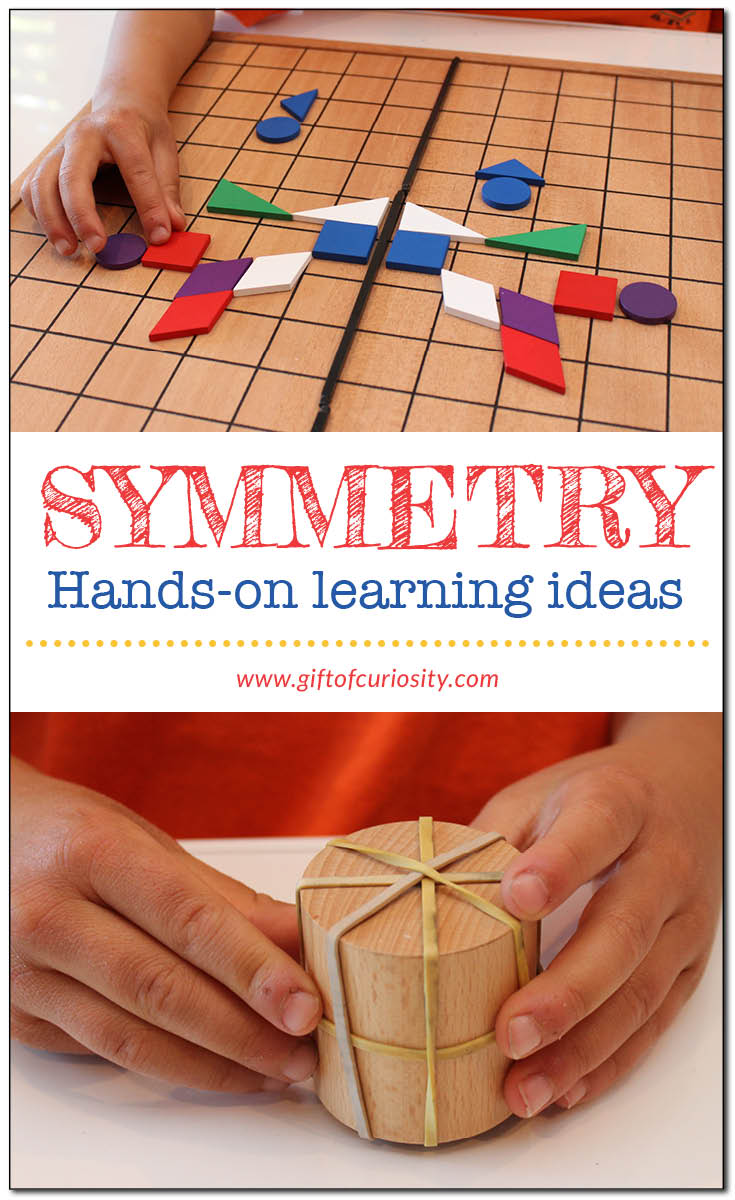
Reflection symmetry is the quality of having identical, facing parts. Thus, a symmetrical object can be divided into parts that are mirror images of each other.
One goal when teaching symmetry is to help children see symmetry in images and real-world objects. This can be done by having children create symmetrical designs and by having them find the line of symmetry in real objects.
I sat down with my son one day to do some hands-on symmetry activities using parts from our Spielgaben set .
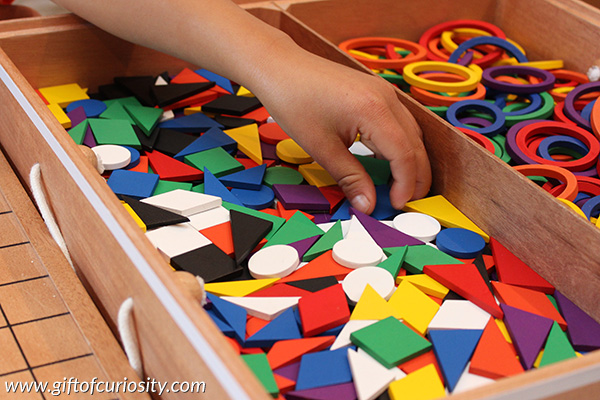
Create symmetrical designs
Symmetry is an important concept in art. Artists play with symmetry in various ways to affect the look and feel of their work. Creating symmetrical designs allows children to play with symmetry and art together.
I built a line down the middle of a grid using long, black sticks. I then placed two shapes on one side of the line and challenged my son to build the reflection.
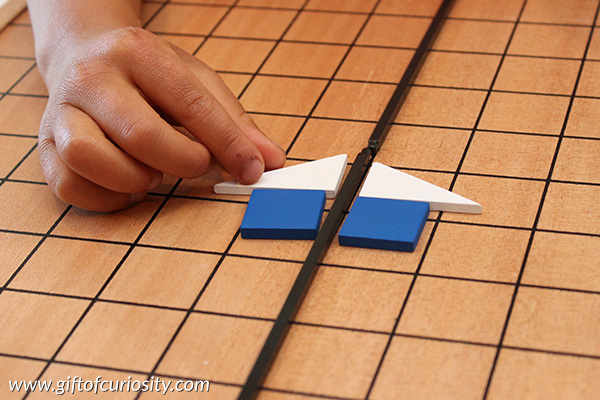
We kept adding more shapes to our design.

And we added some more. He was able to build the symmetrical reflection with ease, but other kids may need some support if they are just learning this concept or if they struggle with spatial awareness.
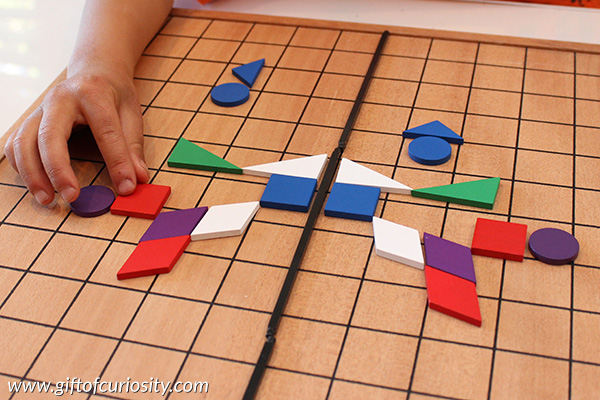
After building symmetrical reflections, we tried something else.
Finding the line of symmetry in 3-D objects
Another great skill for children is to be able to find the line of symmetry in both 2-D and 3-D objects. There are a number of great activities for finding the line of symmetry in 2-D objects in my Basic Symmetry Activity Pack .
In this activity, however, my son worked on finding lines of symmetry in 3-D objects.
I handed my son a cube and some rubber bands, and I asked him to use a rubber band to indicate the line of symmetry on the cube.
He found the first line easily.
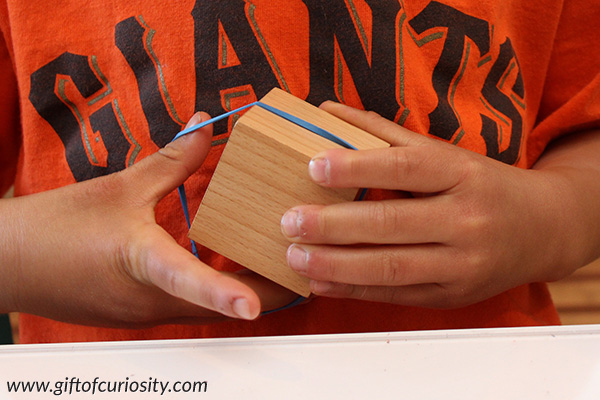
But I challenged him to find more lines of symmetry on the cube.
It took him a bit of time to find the diagonal lines of symmetry, but he did it.
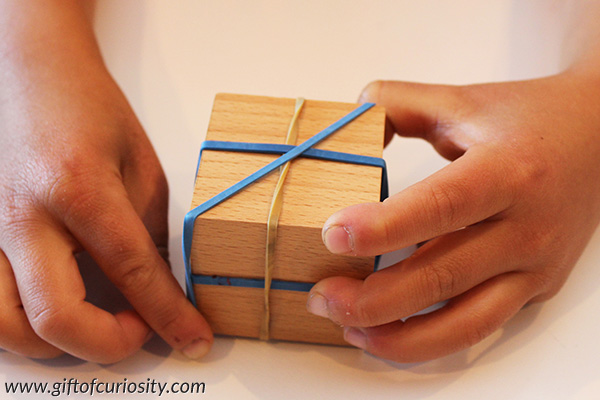
Then I handed him a cylinder and again I asked him to mark the lines of symmetry with rubber bands.
He found one line of symmetry around the circumference of the barrel. And then he found lots of lines of symmetry on the vertical plane.
Fun fact: A cylinder has an infinite number of lines of symmetry.

If you enjoy these activities, you’ll also enjoy my Basic Symmetry Activity Pack with more than 40 hands-on learning ideas for teaching kids about reflection symmetry or my Advanced Symmetry Activity Pack with 20+ hands-on activities for teaching kids about rotational symmetry.
More resources for teaching math
More math activities from Gift of Curiosity:
- Basic Symmetry Activity Pack
- Building a 3D rainbow measurement activity
- Adding with chain links
- Teaching combinations of 10
- Introduction to probability
- Math practice with numbered dice
- Put the numbers on the clothesline
- Road numbers
For more activities, resources, and printables for teaching math, see my Math Activities for Kids page and my Math Pinterest board .
You May Also Enjoy These Posts

Symmetry: What It Is And How to Find It
Today you will learn what symmetry is and we will see some symmetry exercises that children do during their Smartick sessions and the typical mistakes that are usually made.
What is Symmetry?
Symmetry is one of the mathematical concepts that students start to learn about outside of school. Yet, they still study it in early childhood education and build symmetrical figures without utilizing a rigorous definition.
As we will see below, there are various types of symmetry. We are going to begin with the most well-known, symmetry with respect to a line or axial symmetry . Let’s start by drawing a straight line on a plane, which in this case it can be on a piece of grid paper like what is pictured below:

We say that a figure is symmetrical with respect to a line when each point on one side of that line has another point on the other side, and at the same distance, from that line.
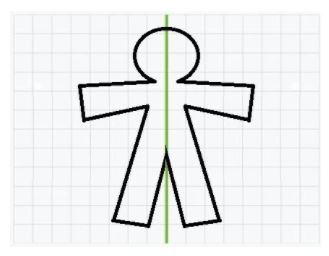
If we want to know if an image is symmetrical with respect to a line and we have it on the piece of paper, we just need to fold the paper along the line. If when we fold the paper and the figures coincide with one another it is because they are symmetrical with respect to the line. If they do not coincide then they are not symmetrical.
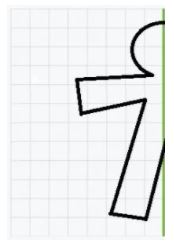
If we want to create a symmetrical image on the paper, we begin by folding the paper and, using a marker that will bleed through the paper slightly, we draw the figure that we want. Then we unfold the paper. The marker has bled to the other side and has created two figures that are symmetrical with respect to the line that we had folded. When the paper is folded, they match up exactly. We could also use scissors instead of a marker.
Video: Symmetrical Figures and Axes of Symmetry
To better understand what symmetry is with respect to an axis , take a look at this video of one of our interactive tutorials. It is no longer interactive but you have the advantage of being able to watch it as many times as necessary and sharing it with others. If you would like to access the real interactive tutorials, register with Smartick , the online math learning method for children ages 4 to 14.
In this video we present a symmetry workshop, take a look:
What is an Axis of Symmetry?
A symmetrical figure can have one or various axes of symmetry, that can be straight lines or lines that divide the figure into two symmetrical parts.
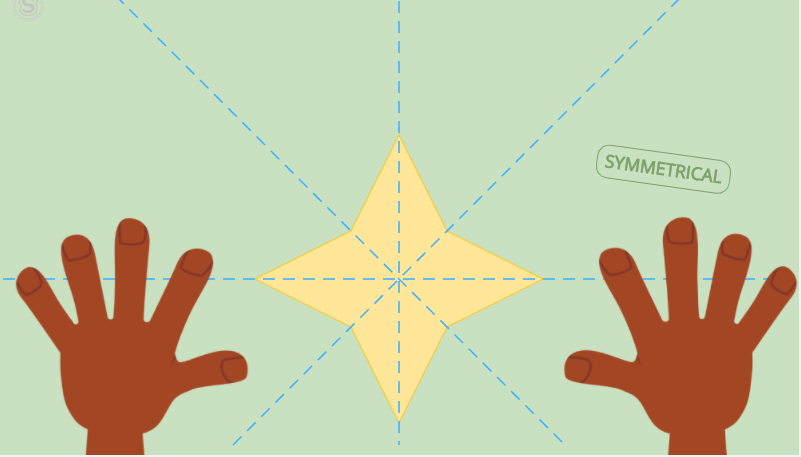
In the image, taken from the video, the star has four axes of symmetry and the hands only have one – vertical straight.
Types of Symmetry
There are many types of symmetry but we are going to focus on these three which are the ones that would be seen in school:
- First, axial symmetry, or symmetry with respect to a line, is the one that divides an object or figure in two using a straight line , in other words, by an axis of symmetry. This type of symmetry might resemble when we look in the mirror and see our reflection in it.
- We say that one or more figures have rotational symmetry when they are not altered when rotated at a certain angle. The four-pointed star in the previous image has rotational symmetry because if you turn it 90º (or any multiple of 90º) it will be the same.
- The third type of symmetry that occurs on a plane is symmetry with respect to a point or central symmetry . Two points are symmetrical with respect to a point – which we call the center of symmetry – if they are the same distance from it and on the same line. Central symmetry produces the same effect as a 180º turn.
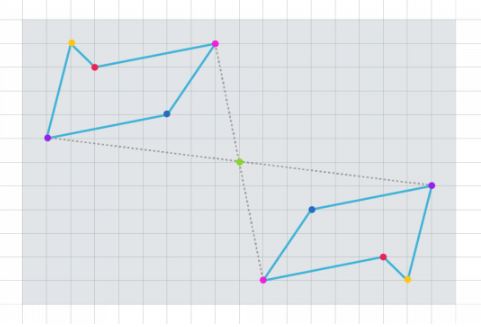
Symmetry Exercises in Smartick
In the post about new Smartick content , we gave examples of the sequence of symmetry activities. The difficulty varies with the shape of the figures and the orientation of the axis of symmetry. The difficulty gradually increases, little by little, facilitating learning and comprehension of this concept. These exercises promote the development of spatial vision and geometric reasoning.
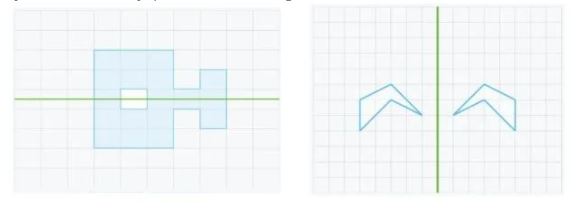
- In others they must construct symmetrical figures:
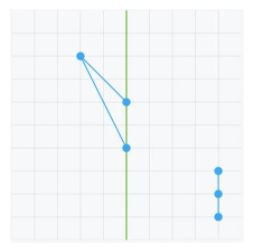
- Or place a series of points symmetrically on an oblique axis:
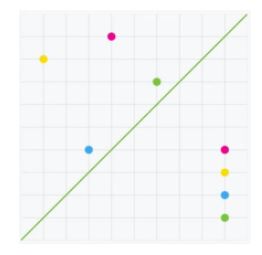
Typical Mistakes
Are these two figures symmetrical with respect to the axis? There are two mistakes that students often make when faced with this question.
- Think about if the figures are identical, if they are then they are symmetrical:
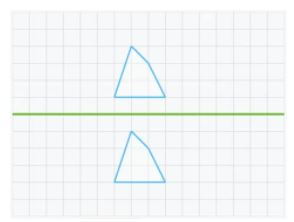
In order to correct this error, (as we mentioned earlier) it is useful to think of the grid as a paper that can be folded on the axis of symmetry. If when folded, the figures do not coincide it is because they are not symmetrical. Another way is to think of the axis as a mirror, if one figure is not the reflection of the figure that would be projected in the mirror, then they are not symmetrical.
- Another common mistake is to think that if one figure is the specular reflection of another then they are symmetrical regardless of their position with respect to the axis of symmetry:
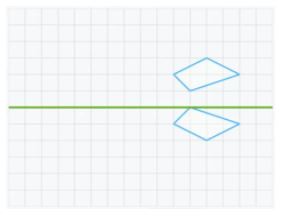
We can use the same strategies as before to eliminate this mistake. If we fold the paper along the axis of symmetry the figures do not match. And one figure is not the reflection of the other in the axis mirror. Therefore, these two figures are not symmetrical with respect to the axis.
Symmetry Outside of Mathematics
Symmetry is all around us:
- In a mirror or the reflection on the water’s surface. The image reflected is symmetrical to the real image.
- In ourselves: we have a right hand and a left hand, a right ear, and a left ear, and each pair is symmetrical. Our body is divided into two symmetrical parts, right and left, with respect to an axis that runs from the top of our heads to our toes.
- The majority of houses and buildings have facades that are symmetrical with respect to a vertical axis.
- Cars, toasters, cell phones, a glass, a plate, a bottle, a television, a sofa… most daily objects have one or more axes of symmetry.
- We can also find symmetry in art. Artists use symmetry in painting, sculpture, music, and countless other disciplines.
- In nature too. The majority of animals and plants have some type of symmetry: bilateral, radial…
If you would like to learn more about primary school geometry and mathematics, register with Smartick and try it for free.
Learn More:
- Identifying Flat Symmetrical Figures
- Trapezium-Trapezoid: Definition, Types and Exercises
- Geometric Figures and Straight Lines
- Mathematical Functions: Do You Know What They Are?
- Elementary Geometry – Open Lines
- 15 fun minutes a day
- Adapts to your child’s level
- Millions of students since 2009

- Recent Posts
- The Language of Functions and Graphs - 07/01/2024
- Educational Technology: The Christodoulou Test - 05/06/2024
- Multiplication Activities in Smartick - 04/09/2024
Add a new public comment to the blog: Cancel reply
The comments that you write here are moderated and can be seen by other users. For private inquiries please write to [email protected]
Your personal details will not be shown publicly.
I have read and accepted the Privacy and Cookies Policy
In Mathematics, symmetry means that one shape is identical to the other shape when it is moved, rotated, or flipped. If an object does not have symmetry, we say that the object is asymmetrical. The concept of symmetry is commonly found in geometry.
| 1. | |
| 2. | |
| 3. | |
| 4. | |
| 5. |

What is Symmetry in Math?
A shape or an object has symmetry if it can be divided into two identical pieces. In a symmetrical shape, one-half is the mirror image of the other half. The imaginary axis or line along which the figure can be folded to obtain the symmetrical halves is called the line of symmetry.
Symmetry Definition
A shape is said to be symmetric if it can be divided into two more identical pieces which are placed in an organized way. For example, when you are told to cut out a ‘heart’ from a piece of paper, you simply fold the paper, draw one-half of the heart at the fold and cut it out to find that the other half exactly matches the first half. The heart carved out is an example of symmetry. Similarly, a regular pentagon when divided as shown in the image below, has one part symmetrical to the other.

The definition of Symmetry in Math, states that “symmetry is a mirror image”, i.e., when an image looks identical to the original image after the shape is being turned or flipped, then it is called symmetry. Symmetricity exists in patterns. It is a balanced and proportionate similarity found in two halves of an object, which means one-half is the mirror image of the other half. Symmetric objects are found all around us in day-to-day life, in art, and in architecture.
Line of Symmetry
The line of symmetry is a line that divides an object into two identical pieces. Here, we have a star and we can fold it into two equal halves. When a figure is folded in half, along its line of symmetry, both the halves match each other exactly. This line of symmetry is called the axis of symmetry .

The line of symmetry can be categorized based on its orientation as:
Vertical Line of Symmetry
Horizontal line of symmetry, diagonal line of symmetry.
A vertical line of symmetry is that line that runs down vertically, divides an image into two identical halves. For example, the following shape can be split into two identical halves by a standing straight line . In such a case, the line of symmetry is vertical.

The horizontal line of symmetry divides a shape into identical halves, when split horizontally, i.e., cut from right to left or vice-versa. For example, the following shape can be split into two equal halves when cut horizontally. In such a case, the line of symmetry is horizontal.

A diagonal line of symmetry divides a shape into identical halves when split across the diagonal corners. For example, we can split the following square shape across the corners to form two identical halves. In such a case, the line of symmetry is diagonal.

A line of symmetry is an axis along which an object when cut, will have identical halves. These objects might have one, two, or multiple lines of symmetry.
- One line of symmetry
- Two lines of symmetry
- Infinite lines of symmetry
One Line of Symmetry
Figures with one line of symmetry are symmetrical only about one axis. It may be horizontal, vertical, or diagonal. For example, the letter "A" has one line of symmetry, that is the vertical line of symmetry along its center.
Two Lines of Symmetry
Figures with two lines of symmetry are symmetrical only about two lines. The lines may vertical, horizontal, or diagonal lines. For example, the rectangle has two lines of symmetry, vertical and horizontal.
Infinite Lines of Symmetry
Figures with infinite lines of symmetry are symmetrical only about two lines. The lines may vertical, horizontal, or diagonal lines. For example, the rectangle has two lines of symmetry, vertical and horizontal.
The following table shows the examples for different shapes with the number of lines of symmetry that they have.
| Number of lines of symmetry | Examples of figures |
|---|---|
| No line of symmetry | Scalene triangle |
| Exactly one line of symmetry | Isosceles triangle |
| Exactly two lines of symmetry | Rectangle |
| Exactly three lines of symmetry | Equilateral triangle |
Types of Symmetry
Symmetry can be viewed when you flip, turn or slide an object. There are four types of symmetry that can be observed in various cases.
- Translational symmetry
- Rotational symmetry
- Reflexive symmetry
- Glide symmetry
Translation Symmetry
If an object is moved from one position to another, with the same orientation in the forward and backward motion, it is called translational symmetry. In other words, translation symmetry is defined as the sliding of an object about an axis. For example, the following figure, where the shape is moved forward and backward in the same orientation by keeping the fixed axis, depicts translational symmetry.

Rotational Symmetry
When an object is rotated in a particular direction, around a point, then it is known as rotational symmetry, also known as radial symmetry. Rotational symmetry exists when a shape is turned, and the shape is identical to the origin. The angle of rotational symmetry is the smallest angle at which the figure can be rotated to coincide with itself and the order of symmetry is how the object coincides with itself when it is in rotation.
In geometry, there are many shapes that depict rotational symmetry. For example, figures such as circle, square, rectangle depict rotational symmetry. The following image shows how the structure of a starfish follows rotational symmetry. If you turn or rotate the starfish about point P, it will still look the same from all directions. The famous Ferris wheel, the London Eye, is an example of rotational symmetry. You can find many objects in real life that have rotational symmetry like wheels, windmills, road-signs, ceiling fans, and so on.

Reflexive Symmetry
Reflective symmetry, also called mirror symmetry, is a type of symmetry where one half of the object reflects the other half of the object. For example, in general, human faces are identical on the left and right sides.

Glide Symmetry
Glide symmetry is the combination of both translation and reflection transformations. A glide reflection is commutative in nature and the change in combination’s order does not alter the output of the glide reflection.
Fun Facts on Symmetry
- A kaleidoscope has mirrors inside it that produce images that have multiple lines of symmetry. The angle between the mirror decides the number of lines of symmetry.
- We may have observed several symmetrical objects in our daily life like rangolis or kolams. The striking aspect of symmetry can be observed in rangoli designs. These designs are famous in India for their unique and symmetrical patterns. They depict the colorful science of symmetry.
What is Point Symmetry?
An object has a point symmetry if every part of the object has a matching part. Many letters of the English alphabet have point symmetry. The point O is the central point and the matching parts are in opposite directions.

If an object looks the same when you turn it upside down, then it is said to have point symmetry. The shape and the matching parts must be in opposite directions.
Important Notes
Given below are some important points related to the concept of symmetry:
- All regular polygons are symmetrical in shape. The number of lines of symmetry is the same as the number of its sides.
- An object and its image are symmetrical with reference to its mirror line.
- If a figure has rotational symmetry of 180º, then it has point symmetry.
☛Related Topics
Listed below are a few topics that are related to symmetry.
- Is a square a rectangle
- Diagonal of Rectangle Formula
Symmetry Examples
Example 1: If the following figure shows a reflexive line of symmetry, complete the figure.

It is given that the figure has a reflexive line of symmetry. That means the second half or the missing part of the figure will be exactly the same as given on the other side.
Thus, the complete figure is:

Example 2: Identify which of the following figures is symmetrical about the given line l?

As we know, when an object is exactly the same when you turn it or flip it, that object has symmetry.
Thus, from the above-given figures, only figure (c) has symmetry.
Example 3: Look at the shape on the left side and identify how the shape has been transformed.
(a) Rotation (b) Reflection

These images are depicting one most important property of reflection symmetry - The first image on the left follows lateral inversion, that is left side appears to be the right side as it happens when you look in a mirror. Therefore, it shows reflection symmetry.
go to slide go to slide go to slide

Book a Free Trial Class
Practice Questions on Symmetry
Faqs on symmetry.
Symmetry is defined as a proportionate and balanced similarity that is found in two halves of an object, that is, one-half is the mirror image of the other half. For example, different shapes like square, rectangle, circle are symmetric along their respective lines of symmetry.
What is a Symmetrical Shape?
A 2D shape can be called symmetrical if a line can be drawn through it and either side is a reflection of the other. For example, a square has a symmetrical shape.
What are the 4 Types of Symmetry?
Symmetry can be categorized into four types:
- Translational symmetry: If the object is moved or translated from one position to another, the same orientation in the forward and backward motion is called translational symmetry.
- Rotational symmetry: When an object is rotated in a particular direction, around a point, then it is known as rotational symmetry.
- Reflexive symmetry: Reflective symmetry, also called mirror symmetry, is a type of symmetry where one half of the object reflects the other half of the object.
- Glide symmetry: Glide symmetry is the combination of both translation and reflection transformations.
What is the Symmetry Meaning? Explain With an Example.
When an object is exactly the same when you turn it or flip it, that object has symmetry. Symmetrical objects are of the same size and shape. Nature has plenty of objects having symmetry. For example, the petals in a flower, a butterfly, etc.
What is a Symmetric Pattern?
All patterns having symmetry are called symmetric patterns. The leaves of plants have various patterns and shapes. Most of these leaves depict symmetric patterns if we take the middle vein as the line of vertical symmetry.
What Do you Mean by a Line of Symmetry?
The line of symmetry is a line that divides an object into two identical pieces. For example, the diagonal of a square divides it into two equal halves, this is referred to as the line of symmetry for a square.
Can a line of symmetry be parallel?
No, the line of symmetry cannot be parallel. All lines of symmetry drawn for any shape will always coincide with each other.
How to Find Symmetry

Hey there! Welcome to this video on symmetry. Let’s get started!
What happens when I take these two shapes,

and I split them in half?

The shapes are identical in size and shape, right? I can see this more clearly by folding the images on top of each other.
So, we can see that when I have drawn a line, I have created two congruent shapes . Congruent means that the two shapes are identical. When you are able to draw a straight line through the center of a shape, and it creates two congruent shapes, then these two shapes are also symmetrical.
Symmetry comes from the Greek word symmetria meaning “a similar agreement of parts.”
Symmetry, just like congruent shapes, means that one shape becomes exactly like the other when you move it in some way. The movement could be a turn, a flip, or a slide.
When a shape is not symmetrical, then this is referred to as asymmetrical.
Some shapes have lines of symmetry. A line of symmetry is a line that splits the shape in half, creating an identical shape. Some shapes only have one line of symmetry, some have two, and some have several!
However, to draw a line of symmetry, we must first identify the point of symmetry. This is because the point of symmetry marks the point that the lines of symmetry could pass through.
A point of symmetry is when there is a position or central point on an object or shape where the central point splits the object into two identical parts. And, every single line and angle on the other side of the central point is the same exact distance from the central point on each side.
That was a lot. Let’s take a look at what I mean.
Where both identical lines of the cross intersect, we can see that there is a point of symmetry, but let’s take a look at the definition to make sure.
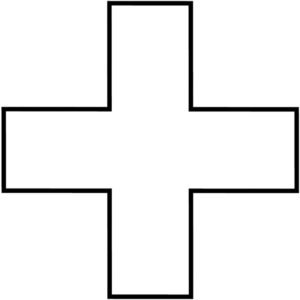
So let me draw this line here, this point of symmetry.
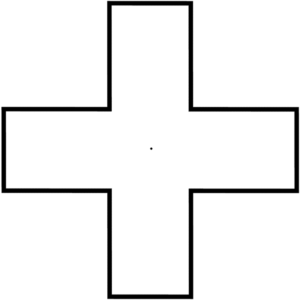
Okay, does the point split the cross into two identical, or congruent, shapes? Well, if we imagined folding it over across this point, it would then split it in half. So, check!
Is every single line or angle of the cross the exact same distance from the point on each side?
So “are all these angles congruent and the same exact distance from this point” is our question.
Based on what we can see, it definitely appears that way. However, to be one hundred percent sure, we would need to measure every single line and angle. But, for this exercise, I have used an example where we are assuming all the lines and angles are the exact same distance, so check!
Now, let’s practice finding lines of symmetry.
Since we’ve already found the point of symmetry on the cross, let’s see how many lines of symmetry it has. How many times can we split the cross, and get identical parts?
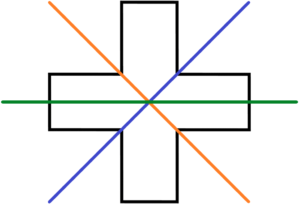
That gives us: 1, 2, 3, 4. So there are 4 lines of symmetry here, but after 4, there are no other lines that would give us two identical parts.
Let’s try another.
How many lines of symmetry does the dog have? Or how many lines can you draw that create multiple identical parts?
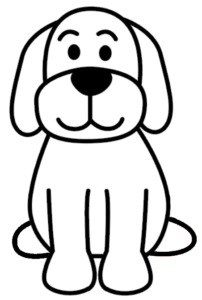
Let’s see. If we did it through the center horizontally, we wouldn’t get two identical parts because he has a lower half and then a head. So if we do it through the center from the top to the bottom, we’ll get two eyes, two parts of the nose, two halves of the mouth, two halves of the body, and two of the legs.

So we can see there’s one line of symmetry.
If there were any more lines, then we would not have identical parts.
What about the side of the dog? Do you see any lines of symmetry?

No. Each end of the dog has different-shaped parts. The head is different than the tail. Let’s move on.
Okay, now what about this thought bubble?

Is there a line you can draw to create two identical parts? No.
Let’s see how many lines we can draw to split this hexagon into identical parts.
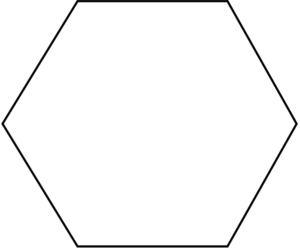
1, 2, 3, 4, 5, 6.

You guys have done a really great job.
Keep practicing by looking for shapes that are symmetrical in your classroom, in your house, outside, or wherever you are.
Symmetry is everywhere, and it’s very important. Architects and engineers use symmetry to design sturdy buildings and other objects. Interior designers use symmetry and asymmetrical design to make their work more appealing to look at. People everywhere use symmetry in some way.
I hope that this video was helpful. See you next time!
Symmetry Practice Questions
How many lines of symmetry does a square have?
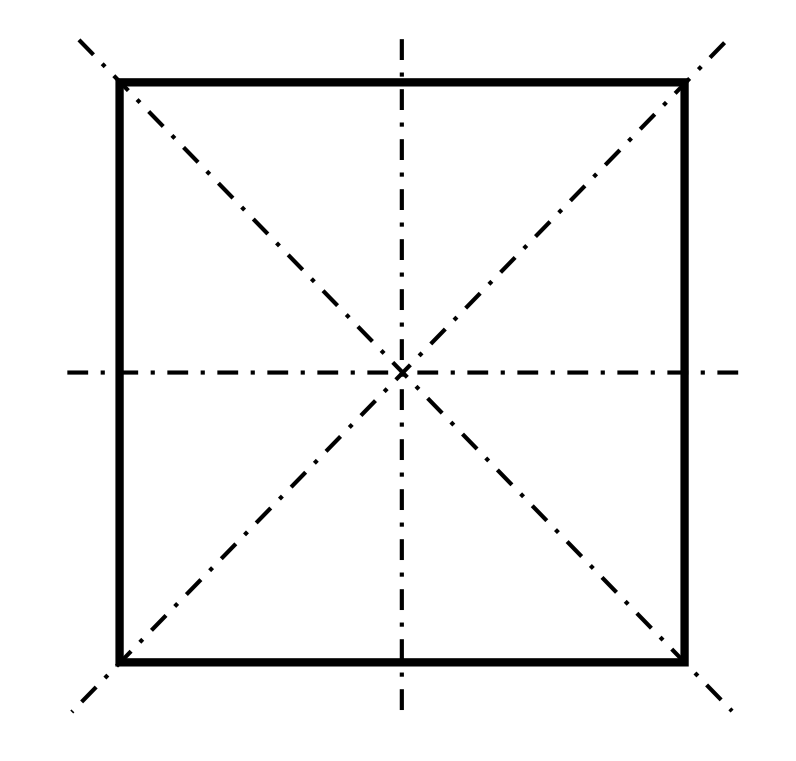
Which letter has exactly two lines of symmetry?

Which image shows a dotted line that is not a line of symmetry?

A line of symmetry splits a shape in half, creating two identical shapes. The two halves of the S shown are not identical. Therefore, the dotted line in Choice D is not a line of symmetry.
Kate is a graphic designer and is creating a logo with the letter H. She needs to identify its lines of symmetry so she can arrange the logo with precision. How many lines of symmetry are in the letter H?
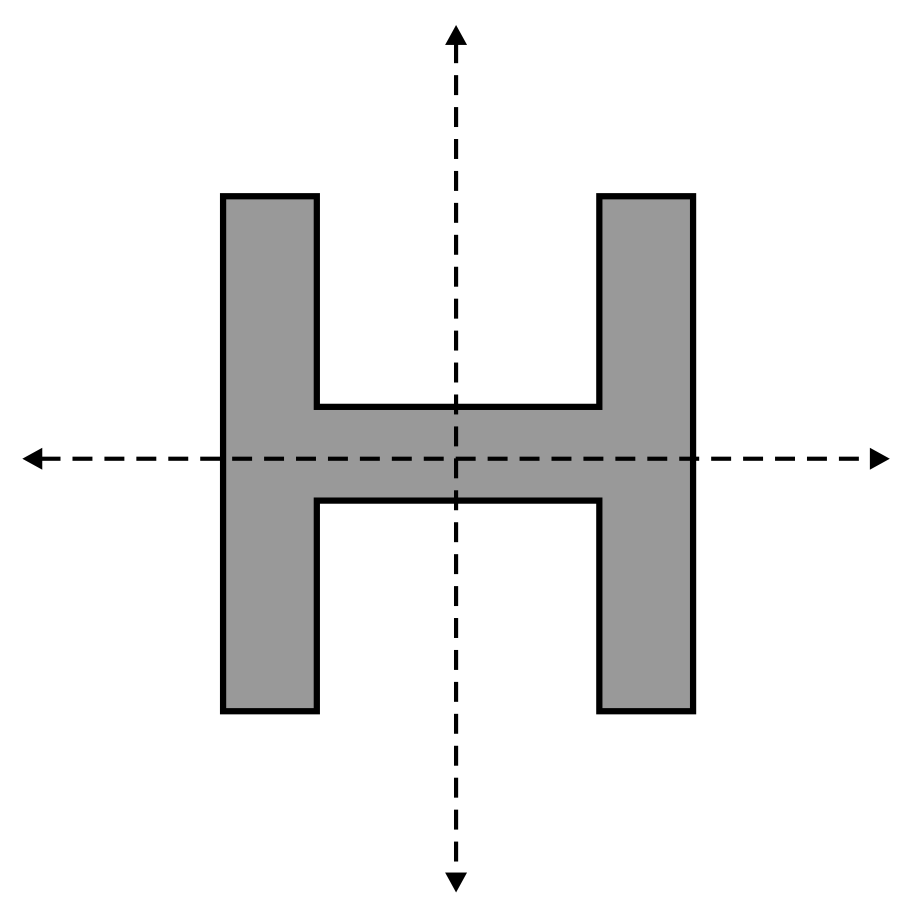
Juan is learning about symmetry in his math class. For homework, his teacher tells the class to find examples of objects that have a point of symmetry. The next day in class, Juan says he found four objects with a point of symmetry: the letter A, a King of Hearts playing card, an hourglass, and a plate. His teacher tells him that all his objects have a point of symmetry except for one. Which of Juan’s objects does not have a point of symmetry?
The letter A
A King of Hearts playing card
An hourglass
A circular plate
Point symmetry occurs when every part of an image has a matching part that is the same distance from the central point but in the opposite direction. The letter A does not have an origin point that divides the figure to create two matching parts in opposite directions. The rest of the objects listed do have point symmetry.
Return to Geometry Videos
by Mometrix Test Preparation | Last Updated: December 26, 2023
- Skills by Standard
- Skills by Grade
- Skills by Category
Go to profile
- Assignments
- Assessments
- Report Cards
- Our Teachers
Remove ads and gain access to the arcade and premium games!
Unlock harder levels by getting an average of 80% or higher.
Earn up to 5 stars for each level The more questions you answer correctly, the more stars you'll unlock!
Each game has 10 questions. Green box means correct. Yellow box means incorrect.
Need some help or instruction on how to do this skill?
Want a paper copy? Print a generated PDF for this skill.
Share MathGames with your students, and track their progress.
See how you scored compared to other students from around the world.
Learn Math Together.
Grade 1 - Geometry and Spatial Sense
Standard 1.GSS.1 - Determine the symmetry of a two dimensional shape in relation to an axis of symmetry.
Included Skills:
Geometric Properties • identify and describe common two-dimensional shapes (e.g., circles, triangles, rectangles, squares) and sort and classify them by their attributes (e.g., colour; size; texture; number of sides), using concrete materials and pictorial representations (e.g., "I put all the triangles in one group. Some are long and skinny, and some are short and fat, but they all have three sides."); • trace and identify the two-dimensional faces of three-dimensional figures, using concrete models (e.g., "I can see squares on the cube."); • identify and describe common three-dimensional figures (e.g., cubes, cones, cylinders, spheres, rectangular prisms) and sort and classify them by their attributes (e.g., colour; size; texture; number and shape of faces), using concrete materials and pictorial representations (e.g., "I put the cones and the cylinders in the same group because they all have circles on them."); • describe similarities and differences between an everyday object and a three-dimensional figure (e.g., "A water bottle looks like a cylinder, except the bottle gets thinner at the top."); • locate shapes in the environment that have symmetry, and describe the symmetry.
If you notice any problems, please let us know .
- STEM Ambassadors
- School trusts
- ITE and governors
- Invest in schools
- Student programmes
- Benefits and impact
- Our supporters
- Advertising and sponsorship
- Become a STEM Ambassador
- Request a STEM Ambassador
- Employer information
- Training and support
- STEM Ambassadors Partners
- Working with community groups
- Search icon
- Join the STEM Community
Good Ideas for Symmetry
While these activities from Polygon Resources focus largely on line symmetry, some lead on to rotational symmetry. Although much of the work in this booklet relates to two dimensional shapes, there are opportunities to extend into three dimensions. The need to think of planes of symmetry rather than lines is a way of ensuring the more able students will meet appropriate challenges.
[b]Tile Patterns[/b] is an activity which uses tiling generators to investigate symmetry in square and rectangular arrangements of tiles.
[b]Polyominoes[/b] uses polyominoes, which are shapes that can be made with squares where complete sides of squares must be touching. Students are asked to make polyominoes out of 3, 4, 5, and 6 squares and investigate their lines of symmetry.
[b]Mirrors[/b] is a problem involving finding where to place a mirror on a starting shape to produce another given shape.
[b]Pegboard Patterns[/b] uses colour and spatial arrangements of pegs on a board to produce patterns with one or two lines of symmetry.
[b]Paper Folds[/b] shows a shape which has been produced by folding a shape in half along a line of symmetry and asks what the possible starting shapes could have been.
[b]Worms[/b] is an activity which involves drawing trails following a rule which can then produce patterns with rotational symmetry.
Show health and safety information
Please be aware that resources have been published on the website in the form that they were originally supplied. This means that procedures reflect general practice and standards applicable at the time resources were produced and cannot be assumed to be acceptable today. Website users are fully responsible for ensuring that any activity, including practical work, which they carry out is in accordance with current regulations related to health and safety and that an appropriate risk assessment has been carried out.
Show downloads
| Subject(s) | Mathematics |
|---|---|
| Age | 7-11, 11-14 |
| Published | 1990 - 1999 |
| Published by | |
| Collections | |
| Direct URL |
Share this resource
Did you like this resource, lists that tag this content, shape , posted by alisonlh, symmetry , posted by stephen lyon, extending more able mathematicians , posted by.

IMAGES
COMMENTS
6. Which diagram represents a line of symmetry of the regular octagon? B. Which statements are true regarding the symmetry of the isosceles trapezoid? Check all that apply. The trapezoid has 1 line of reflectional symmetry. The trapezoid has rotational symmetry of order 1. The line of symmetry is a vertical line.
2. How many lines of reflectional symmetry does an equilateral triangle have? 3. If the smallest angle of rotation for a regular polygon is 18°, how many sides does polygon have? 20. We have an expert-written solution to this problem! Which set of side lengths represents a triangle with 3 lines of reflectional symmetry?
The answer to this question is the graph with 4 lines of symmetry. Essentially, its the graph with the most lines on the square; hope this is clear enough. Click to choose the correct graphic with all the lines of symmetry as defined by a line. The answer to this question is the graph with 2 lines of symmetry.
1. Symmetry Art Swap. For this activity, you'll want to provide individuals with graph paper and art supplies. Every student will begin by creating a "line of symmetry," preferably horizontal or vertical to begin with, through the center of the page. Then, they can create a geometric design of their liking on ONE side of the mirror line.
More math activities from Gift of Curiosity: Basic Symmetry Activity Pack. Building a 3D rainbow measurement activity. Adding with chain links. Teaching combinations of 10. Introduction to probability. Math practice with numbered dice. Put the numbers on the clothesline. Road numbers.
Symmetry • Activity Builder by Desmos Classroom. Loading... In this activity, students develop an informal understanding of symmetry of functions. By the end, students should be able to identify the symmetry of a function (reflectional vs rotational) by considering its graph. French translation courtesy of Mélanie Boucher: https://teacher ...
Draw a line of symmetry through the triangle by connecting two black points. Learn for free about math, art, computer programming, economics, physics, chemistry, biology, medicine, finance, history, and more. Khan Academy is a nonprofit with the mission of providing a free, world-class education for anyone, anywhere.
Symmetry Outside of Mathematics. Symmetry is all around us: In a mirror or the reflection on the water's surface. The image reflected is symmetrical to the real image. In ourselves: we have a right hand and a left hand, a right ear, and a left ear, and each pair is symmetrical. Our body is divided into two symmetrical parts, right and left ...
Symmetry Examples. Example 1: If the following figure shows a reflexive line of symmetry, complete the figure. Solution: It is given that the figure has a reflexive line of symmetry. That means the second half or the missing part of the figure will be exactly the same as given on the other side.
Show Answer. Question #5: Juan is learning about symmetry in his math class. For homework, his teacher tells the class to find examples of objects that have a point of symmetry. The next day in class, Juan says he found four objects with a point of symmetry: the letter A, a King of Hearts playing card, an hourglass, and a plate.
Standard 1.GSS.1 - Determine the symmetry of a two dimensional shape in relation to an axis of symmetry. Included Skills: Geometric Properties • identify and describe common two-dimensional shapes (e.g., circles, triangles, rectangles, squares) and sort and classify them by their attributes (e.g., colour; size; texture; number of sides ...
f is an even function. The function f shown in the graph is an even function. The graph has been hidden for x ≥ 0. Complete the following sentences. f is over the interval 0 < x < 2. f is over the interval 2 < x < 5. Describe the symmetry of these functions. This graph shows a portion of an even function.
Symmetry Tutorial - An interactive point group symmetry tutorial. Guides students through all of the symmetry elements and operations, with interactive displays and animations. The Symmetry Gallery - A collection of over 120 unique molecules and polyhedra with interactive display of all symmetry elements and animation of all operations. The molecules are organized by point group, so you can ...
While these activities from Polygon Resources focus largely on line symmetry, some lead on to rotational symmetry. Although much of the work in this booklet relates to two dimensional shapes, there are opportunities to extend into three dimensions. The need to think of planes of symmetry rather than lines is a way of ensuring the more able students will meet appropriate challenges.
1,2-dichloroethane in the trans conformation has a C2 axis perpendicular to the C-C bond and perpendicular to the plane of both Cl's and both C's, a h plane through both Cl's and both C's, and an inversion center. C2h. 4.2 a. Ethylene is a planar molecule, with C2 axes through the C's and perpendicular to the C-C bond both in the ...
Symmetry Assignment Active Determining Angles of Rotational Symmetry of a Regular Polygon The regular nonag Get the answers you need, now!
In the late 1800's, mathematicians used group theory to classify all of the shapes of crystals that could ever exist in the world. Figure 2: Twinned pyrite crystal. (Source) Tiling patterns -- two-dimensional pictures that repeat in regular ways -- are also an example of symmetry. Many cultures have explored symmetry through tiling patterns ...
The symmetry manifests as the invariance of certain properties of the system or its dynamical evolution, and/or of certain observable quantities associated with the system. 1. Active versus Passive Perspectives Opportunities for confusion arise because at various stages we can often think of a transformation in an
The vertex is on the axis of symmetry, so the axis of symmetry is x = 3. Find any two x-intercepts that have the equivalent distance from the axis of symmetry. Use those x-intercepts to write factors of the function by subtracting their values from x. For example, 2 and 4 are each 1 unit from x = 3, so f(x) = (x - 2)(x - 4) is a possible function.
The E vibrations are asymmetric. c. There are three translational modes, three rotational modes, and six vibrational modes, for a total of 12. With 4 atoms in the molecule, 3N = 12, so there are 3N degrees of freedom in the ammonia molecule. d. All the vibrational modes are IR active (all have x , y , or z symmetry).